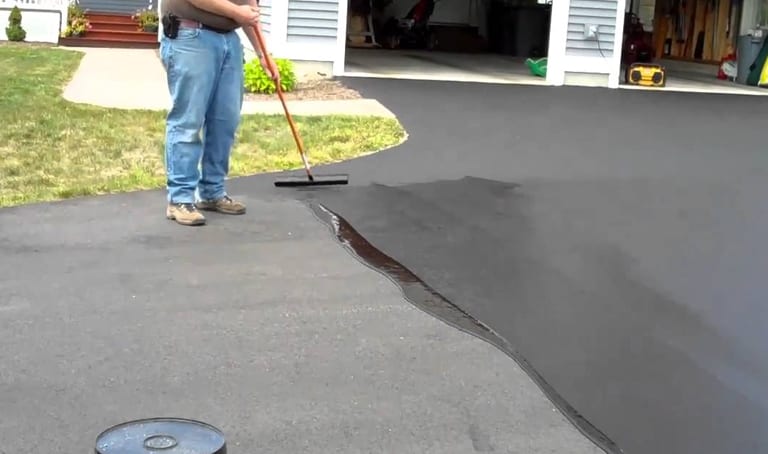Grasping Tilted Parking: How Asphalt Sealing Boosts Business Lots
Hot Mix Asphalt: A Lasting Solution for Sidewalk
Hot Mix Asphalt (HMA) has actually emerged as a leading lasting option for sidewalk remedies, using a myriad of cutting-edge innovations and ecological benefits. As the need for environment-friendly building techniques grows, discovering the nuances of HMA's sustainability can offer valuable insights right into the future of pavement options.
Ecological Advantages of Warm Mix Asphalt

Moreover, Warm Mix Asphalt assists to minimize city warmth island impacts. Its dark shade absorbs sunshine, minimizing the quantity of warm reflected back right into the environment contrasted to lighter-colored sidewalks. This can reduce ambient temperature levels in urban areas, reducing the need for air conditioning and eventually reducing energy intake.
On top of that, Warm Mix Asphalt adds to enhanced stormwater administration. Its permeable nature allows water to infiltrate the sidewalk and reenergize groundwater materials, lowering drainage and the threat of flooding. These ecological advantages make Hot Mix Asphalt a lasting option for leading roadways and freeways.
Power Performance in HMA Manufacturing
Is power effectiveness an important aspect in the production of Warm Mix Asphalt (HMA)? Power plays a considerable role in the manufacturing of HMA, affecting both cost and environmental sustainability. One key element of power effectiveness in HMA production is the usage of cozy mix asphalt (WMA) modern technologies.
Moreover, innovations in plant innovations have actually led to even more energy-efficient HMA manufacturing processes. By enhancing power usage in HMA production, the sector can reduce its carbon footprint while keeping top notch sidewalk products.
Recyclability of Hot Mix Asphalt
The recyclability of Hot Mix Asphalt (HMA) is a crucial facet of its sustainability and long-lasting ecological influence. HMA is one of the most recycled materials in the USA, with over 100 million lots of redeemed asphalt sidewalk (RAP) being recycled annually in new sidewalk building. Recycling HMA uses a number of environmental advantages, such as minimizing the need for virgin materials, decreasing energy consumption during production, and lowering the amount of waste sent to sites landfills.
The process more information of recycling HMA entails grating the existing pavement, squashing it right into smaller pieces, and blending it with new aggregate and asphalt binder to create a recycled mix. Overall, the recyclability of HMA plays a substantial function in promoting lasting methods within the pavement sector.

Long-Term Efficiency of HMA
Asphalt pavements show resilience and strength over an extensive duration, mirroring the long-lasting efficiency of Hot Mix Asphalt (HMA) Furthermore, innovations in HMA innovation, such as the usage of polymer-modified binders and warm mix asphalt, have actually further improved the durability and durability of HMA pavements. By focusing on top quality building and construction and upkeep techniques, HMA continues to verify itself as a cost-efficient and lasting remedy for lasting pavement framework.

HMA: Durability and Sustainability
Showing both toughness and sustainability, Hot Mix Asphalt (HMA) has actually come to be a foundation in the building of durable pavement infrastructures - regrading. HMA's longevity comes from its capacity to stand up to heavy loads, harsh climate condition, and high web traffic quantities, making it a reputable choice for highways, highways, and flight terminal paths. The composition of HMA, which commonly includes aggregates, binder, and filler, plays an essential function in boosting its durability and resistance to deterioration
Furthermore, HMA's sustainability lies in its recyclability and energy-efficient manufacturing process. The capability to recycle reclaimed asphalt pavement (RAP) in new HMA mixtures minimizes the demand for virgin materials and lessens the ecological impact of pavement construction and upkeep. In addition, the power efficiency of creating HMA hinges on its reduced blending temperature levels compared to other pavement materials, causing lowered power intake and greenhouse gas exhausts.
Conclusion
To conclude, warm mix asphalt (HMA) provides a lasting remedy for sidewalk with its eco-friendly characteristics. HMA's recyclability, energy efficiency in production, and long-term toughness make it an eco-friendly choice for road construction. By preserving all-natural sources, minimizing waste, and decreasing greenhouse gas discharges, HMA plays a vital function in advertising sustainability in facilities development. Its capability to reduce urban heat island results better underscores its significance in producing resistant and environmentally aware sidewalk systems.
HMA is More about the author one of the most recycled products in the United States, with over 100 million heaps of recovered asphalt sidewalk (RAP) being reused annually in brand-new sidewalk construction.The procedure of recycling HMA entails grating the existing pavement, squashing it into smaller sized items, and blending it with new aggregate and asphalt binder to produce a recycled mix.Asphalt sidewalks demonstrate sturdiness and resilience over a prolonged duration, mirroring the long-term efficiency of Hot Mix Asphalt (HMA) In addition, improvements in HMA technology, such as the use of polymer-modified binders and cozy mix asphalt, have further boosted the resilience and long life of HMA pavements. The capability to recycle reclaimed asphalt sidewalk (RAP) in new HMA mixes minimizes the need for virgin materials and reduces the ecological effect of pavement building and upkeep.